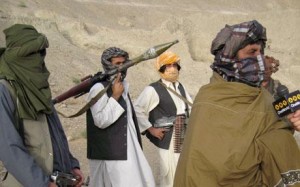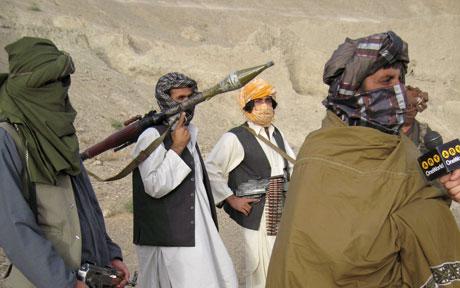The armed conflict with Taliban insurgents and the Karzai government with its international backers for control of the Afghan state is a ‘hybrid[1] internationalized instrastate struggle’[2] playing out on various levels and with both sides receiving external support. It includes a social level with issues of ethnic and religious identity struggles as well as a search for various groups to reform their political and economic marginalization from predatory elites. The conflict is intensified on a global level by a global war on terrorism and by regional actors in a struggle for strategic influence. Regardless, it is critical to remember that these structural dynamics manifest themselves in a predominantly local context. A myriad of complex local interactions form in essence thousands of “micro-insurgencies” that coalesce to form the dyadic conflict.[3] This best explains the dynamic allegiances of Afghan groups shifting to and from those who best satisfy their communal, developmental, political and ideological needs.
The incidence of violent conflict has registered an alarming up-tick. As of mid September 2010, coalition KIA has exceeded 2009’s record high of 521, itself a 77% increase over 2008.[4] Civilian casualties registered a 31% increase as of mid-2010, although the Taliban accounted for the overwhelming majority as coalition forces tightened their rules of engagement.[5] Meanwhile various forms of structural violence persist with the HDI Index ranking Afghanistan 181st out of 182 countries, with abysmal rankings on virtually every metric of human wellbeing.[6]
The Taliban

The Taliban have evolved into a sophisticated insurgency by purposely decentralizing their organizational structure and forming “personal networks formed around charismatic leaders”[11] under the overall command of Mullah Omar and his Quetta Shura, the Taliban’s highest leadership council. Some have argued that Omar’s prolonged absence in the public sphere means only a superficial sense of fealty to his rule now exists. A poll of 42 Taliban militants in Kandahar found a “fascinating lack of loyalty” towards Omar, with over half of respondents believing he was neither required for their war, nor necessarily the best one to lead it either.[12] Others disagree, believing Omar to be the glue that holds the Taliban together, without whom they would “surely collapse into a welter of tribes and factions.”[13] More likely it seems that Omar today is an arbitrator between the disparate networks that subscribe to his authority. His diktats, while carrying immense weight, are not always fully adhered to by a new guard of hyper-radicalized militants.[14]
In a major structural change, a senior commander estimated today that 80% of Taliban fighters are in their late teens or early 20s and that their intensified ideological indoctrination and formative years spent at war have bred a recklessness and contempt for authority that is like “earth and sky” when compared to their anti-Soviet predecessors.[15] As captured journalist David Rohde found to his discomfit, his captors in the Haqqani syndicate, whom he had assumed to be “Al Qaeda Lite,” were actually young, fervent ideologues from radical madrassas professing global jihad.[16] This evolution has also contributed to the decline of command and control mechanisms with effects on conduct, control and discipline. For example, a young militant in Helmand casually dismisses former overall Taliban military commander, Mullah Baradar: “I’m here risking my neck fighting the Americans and he’s eating chicken and pilau in Pakistan… We are here on the ground with our Kalashnikovs and RPGs and we live and die by our own quick judgments. We don’t need to listen to anyone who is not out here putting their life on the line.” [17]
Despite these changes, the departure from a hierarchical mode of battlefield organization has not meant the destruction of a sophisticated centralized apparatus guiding overall strategy and policy. On the contrary, key elements such as impressive intelligence and propaganda networks, a defined code of conduct[18] and significant civil resources to facilitate ‘shadow administration’ are often deployed with great sophistication to precede and augment local autonomous military commands. Recruitment has tapped into various sectors of society to create a “complex adaptive system”[19] that amalgamates the efforts of insurgent groups, transnational terrorist outfits as well as criminal groups, co-opted tribes, local commanders and security elements complicit in the insurgency. This diversity allows for the inclusion of many ideological leanings and alliances, often competing with each other for dominance. The Haqqanis in Loya Paktiya, for example, cooperate with Taliban grand strategy while simultaneously competing for power and influence in certain provinces.[20] They also maintain a close relationship with Pakistani intelligence agencies (notably ISI) in contrast to other networks that resent Pakistani intrusions.[21]
Such a broad jihadi umbrella also allows for the incorporation of various differing motivations at the individual level. A “semi-retired Helmand Taliban commander” describes three echelons of Taliban rank and file; those “who just have problems with the government…. who joined just for power, and the real jihadis who just want to become martyrs.”[22] The poll of Kandahari Taliban found a similar array of professed motivations. Some saw themselves in a religious revolutionary struggle to reshape Afghan political structure into one more Islamic: “Even if you give me so much money that I can’t spend it in my entire lifetime… [I] would continue my fight because I do not want non-Muslims and the people of other religions in my country.” Others spoke of relatives or acquaintances being killed by foreign forces, some of a perceived moral corrosion while most hinted at a strong, religious-nationalist zeal to expel the ‘infidels who enslaved the government.”[23] Also interesting is the 80% who admitted to personal involvement in the opium trade and bemoaned the Western assault on their livelihoods.[24]
Karzai/ISAF
NATO-ISAF forces, now numbering 119,819,[25] are the backbone of military capabilities to support the Karzai government in areas of security, development and reconstruction. The official coalition mandate, now diluted as a result of political pressures, is to create a strong central government with institutions at least capable of combating Taliban forces and denying transnational terrorists sanctuary. However a failure to create adequate governance through the Karzai government has been a key contributor to anarchic conditions prompting British Foreign Secretary David Miliband to remark that coalition and Afghan forces may end up being “outgoverned, rather than outgunned.”[26] Yet, despite staggering missteps towards an increasingly fragmented state, 62% of Afghans continue to support an international force presence and 70% identify the Taliban as the greatest danger to the country.[27]
On paper, the Karzai government and its international backers have created one of the world’s most centralized democracies[28] without adequate resources to extend Kabul’s writ towards the periphery. This radical attempt to transform socio-political structures is especially daunting given governance having historically revolved around a “segmentary kinship system,”[29] with a local sense of identification. To combat the shortfall in central authority, power is outsourced to a variety of regional, and autonomous powerbrokers, often powerful politicians, warlords and criminal warlords all at once. To sit atop this factional pyramid, President Karzai’s centralized model is useful. With the power to appoint every significant official in the executive branch from provincial governors down to the subprovincial level[30], Karzai controls the federal dispensation of patronage, the single most valuable piece of political real estate. Such official patronage at present allows for various profit-making opportunities including siphoning off tax revenues and provincial expenditures, criminal drug, extortion and smuggling rackets along with lucrative security contracts secured with state-subsidized personal militias.[31]







A thorough analysis, yet strangely mentions Indian involvement in the whole quagmire superficially. Reports of Indian involvement in arming factions of taliban are rampant. It mentions ISI’s involvement but leaves out the RAW and its activities which reportedly range from arming taliban on Pakistani side to providing support to insurgents in Pakistani Balochistan!
An interesting view of the current situation in Afghanistan as a complex adaptive system. Similar to Eric Berlow’s analysis of the popular support of Afghanistan government at TED. He found it is good to “step back” and “embrace complexity,” as you have in this article. It is also helpful to see allegiances as a sort of adaptive behavior, as you imply – shifting to the most emergent insurgent.
The Eric Berlow link was extremely interesting. Thank you.